water_sensitive_urban_design澳大利亚节水型城市设计
澳大利亚的海绵城市

澳大利亚的海绵城市2016-11-16 22:29:01 来源:海绵城市水工网在城市发展中,澳大利亚的很多城市都面临城市防洪、水资源短缺和水环境保护等方面的挑战。
作为城市水环境管理尤其现代雨洪管理领域的新锐,以墨尔本为代表,其倡导的WSUD水敏性城市设计(Water Sensitive Urban Design)和相关持续的前沿研究,使其逐渐成为城市雨洪管理领域的世界领军城市。
澳大利亚水资源状况澳大利亚水资源总量力3430亿m3,目前已开发利用的地表水和地下水资源量为175亿m3。
水资源状况的基本特点:一是总量少,人均占有量多。
二是地区分布不均。
三是降水年内、年际分配不均。
相对丰富的水资源与较少的人口使澳大利亚水问题并不突出,但是,随着人口的增加和经济社会的发展,局部地区对水资源的过度开发利用造成潜在影响渐渐显现出来,新的水量分配问题、主要河流的水质问题、灌溉区域的次生盐碱化问题以及地下水的不合理开采问题愈来愈引起人们的关注。
加强水资源管理已成为澳大利亚联邦和各州政府的紧迫任务。
澳大利亚干旱图广大的西北、中部确实是干旱的,但东部沿海,还有其他个别地方气候还是比较湿润的,颜色越蓝的地区降水越多。
澳大利亚水资源的粗放利用(包括过度开发、粗放灌溉和污水随意排放)引发的环境问题在20世纪60年代爆发,灌溉引起的盐碱化和内涝问题非常严重。
90年代初,由于用水增长导致河道水量减少,墨累河滋生的大量蓝藻,造成震动全国的水质危机。
这一切,促使政府对水资源的承载能力进行重新评估,并启动了以控制水的需求为主的水改革。
澳大利亚水资源管理经验澳大利亚以州政府为中心形成了权责明确、适度统一、运转有效的水资源管理体制。
这样的结构有利于管理信息的传播和反馈,能够制订出符合实际的政策,减少实施的环节,避免政出多门的矛盾。
水价改革是澳大利亚供水业改革的关键,各地新水价的制订和供水企业化几乎是同步进行的。
目前,澳大利亚不论是城市供水企业,还是农业灌溉公司都能盈利运行。
国外雨洪管理对中国海绵城市建设的启示
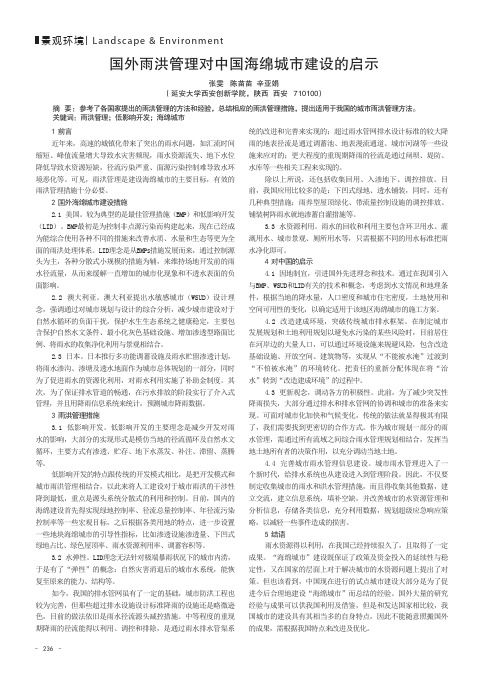
景观环境Landscape & Environment– 236 –1 前言近年来,高速的城镇化带来了突出的雨水问题,如汇流时间缩短、峰值流量增大导致水灾害频现,雨水资源流失、地下水位降低导致水资源短缺,径流污染严重、面源污染控制难导致水环境恶化等。
可见,雨洪管理是建设海绵城市的主要目标,有效的雨洪管理措施十分必要。
2 国外海绵城市建设措施2.1 美国。
较为典型的是最佳管理措施(BMP)和低影响开发(LID)。
BMP最初是为控制非点源污染而构建起来,现在已经成为能综合使用各种不同的措施来改善水质、水量和生态等更为全面的雨洪处理体系。
LID理念是从BMPs措施发展而来,通过控制源头为主,各种分散式小规模的措施为辅,来维持场地开发前的雨水径流量,从而来缓解一直增加的城市化现象和不透水表面的负面影响。
2.2 澳大利亚。
澳大利亚提出水敏感城市(WSUD)设计理念,强调通过对城市规划与设计的综合分析,减少城市建设对于自然水循环的负面干扰,保护水生生态系统之健康稳定,主要包含保护自然水文条件、最小化灰色基础设施、增加渗透型路面比例、将雨水的收集净化利用与景观相结合。
2.3 日本。
日本推行多功能调蓄设施及雨水贮留渗透计划,将雨水渗沟、渗塘及透水地面作为城市总体规划的一部分,同时为了促进雨水的资源化利用,对雨水利用实施了补助金制度。
其次,为了保证排水管道的畅通,在污水排放的阶段实行了介入式管理,并且用降雨信息系统来统计,预测城市降雨数据。
3 雨洪管理措施3.1 低影响开发。
低影响开发的主要理念是减少开发对雨水的影响,大部分的实现形式是模仿当地的径流循环及自然水文循环,主要方式有渗透、贮存、地下水蒸发、补注、滞留、蒸腾等。
低影响开发的特点跟传统的开发模式相比,是把开发模式和城市雨洪管理相结合,以此来将人工建设对于城市雨洪的干涉性降到最低,重点是源头系统分散式的利用和控制。
目前,国内的海绵建设首先得实现绿地控制率、径流总量控制率、年径流污染控制率等一些宏观目标,之后根据各类用地的特点,进一步设置一些地块海绵城市的引导性指标,比如渗透设施渗透量、下凹式绿地占比、绿色屋顶率、雨水资源利用率、调蓄容积等。
墨尔本

墨尔本 地理优势
地理位置 墨尔本经纬度为南纬37度50分 东经144度58分,墨尔本地处平原,有少量的 矮山地,墨尔本也是一个海边城市,面对太平洋,位于东经147度,南纬39度 的位置。墨尔本有一条亚拉河(Yarra River,又译雅拉河),是流经墨尔本的 主要大河流,全长242公里,每年的流量达7.18亿立方米,总流域面积4000平 方公里。墨尔本整个城市最初就是沿着雅拉河两岸建设开去的,到2011年为 止,雅拉河上跨越两岸的桥梁有25座之多。 气候 墨尔本的气候属于亚热带与温带交叉型气候,最热月通常最高平均气温25℃, 最低平均气温14℃,最冷月在3℃到15℃之间,终年多雨,属于温带海洋性气 候。处于向亚热带过渡的地带,夏季偶有最热月超过40摄氏的情形。夏天人 们喜欢去海边玩,在炎热的夏天,日间气温最高可达到四十摄氏度以上。墨 尔本的气候比较干燥,相对湿度常在30%到50%之间,由于干燥,平时晾晒衣 物也干得快,衣服家具等物品不容易发霉,冬天在同样的低温下与湿度高的 地方比较也不觉得那么寒冷,在生活上,墨尔本这样的湿度让很多人觉得舒 适。由于地理位置和洋流影响的原因,墨尔本日夜温差较大,夏天即使白天 气温高达三十多度,晚上就会凉下来至十二度左右,因此墨尔本的气温有 「一天四季」的说法。在冬天,墨尔本不太冷,冬天一般日间气温在十摄氏 度以上,冬天并不下雪,但墨尔本的周围有许多山,冬天的时候寒冷的高山 上有积雪,所以每逢冬季,墨尔本附近的高山又是滑雪的好地方。
墨 尔 本 雨 水 花 园
墨尔本是澳大利亚的文化、商业、教育、娱乐、体育及旅游中心,在2011年、 2012年和2013年连续3年的世界宜居城市评比中均摘得桂冠。与世界其他大城 市一样,在城市发展中,墨尔本也面临城市防洪、水资源短缺和水环境保护 等方面的挑战。墨尔本倡导的WSUD水敏性城市设计(Water Sensitive Urban Design)和相关持续的前沿研究,使其逐渐成为城市雨洪管理领域的世界领 军城市。墨尔本提出的水敏性城市理念中,引入了雨水、地下水、饮用水、 污水及再生水的全水环节管理体系。目前,澳大利亚要求2公顷以上的城市开 发必须采用WSUD技术进行雨洪管理设计。首先,要控制径流量。开发后防 洪排涝系统(河道、排水管网等)上、下游的设计洪峰流量、洪水位和流速 不超过现状。其次,要保护受纳水体水质。项目建成后的场地初期雨水需收 集处理,通过雨水水质处理设施使污染物含量达到一定百分比的消减,可排 入下游河道或水体。因此,水质处理目标要根据下游水体的敏感性程度来确 定。再有,雨洪处理设施要融入城市景观,力求功能和景观的融合,将雨水 作为一种景观要素。此外,还有尽可能增加雨水收集回用机会。在工程实践 中,采用的水量控制措施,主要包括透水铺装、下凹绿地、地下储水池及雨 洪滞蓄水库(人工湖、雨洪公园)等;水质处理措施主要包括道路雨水口截 污装置,植被缓冲带、排水草沟、生态排水草沟,泥沙过滤装置、泥沙沉蓄 池、雨水花园、人工湖及人工湿地等。在工程建设中,要综合考虑当地水文 气象和地形条件,结合城市规划、防洪排涝规划、景观布局等,合理选择布 局上述WSUD措施或其组合。设计中一般需应用多种水文、水力和水质数学 模型进行定量的分析计算,确保水量和水质控制目标的达成。 ——转摘
澳大利亚“水敏感城市设计”概述及启示
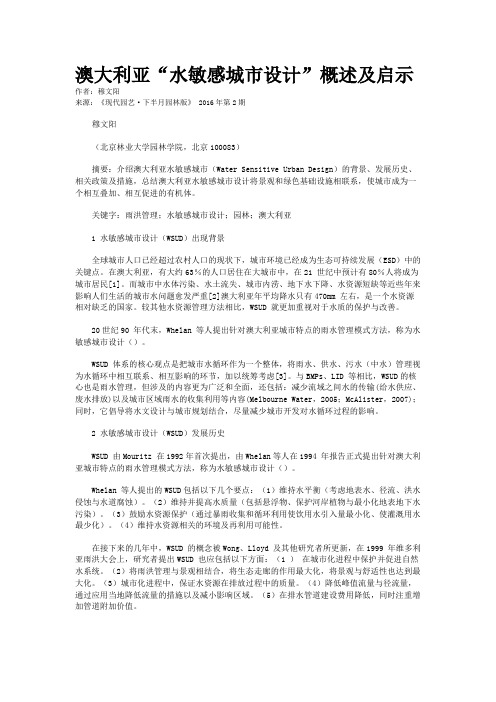
澳大利亚“水敏感城市设计”概述及启示作者:穆文阳来源:《现代园艺·下半月园林版》 2016年第2期穆文阳(北京林业大学园林学院,北京100083)摘要:介绍澳大利亚水敏感城市(Water Sensitive Urban Design)的背景、发展历史、相关政策及措施,总结澳大利亚水敏感城市设计将景观和绿色基础设施相联系,使城市成为一个相互叠加、相互促进的有机体。
关键字:雨洪管理;水敏感城市设计;园林;澳大利亚1 水敏感城市设计(WSUD)出现背景全球城市人口已经超过农村人口的现状下,城市环境已经成为生态可持续发展(ESD)中的关键点。
在澳大利亚,有大约63%的人口居住在大城市中,在21 世纪中预计有80%人将成为城市居民[1]。
而城市中水体污染、水土流失、城市内涝、地下水下降、水资源短缺等近些年来影响人们生活的城市水问题愈发严重[2]澳大利亚年平均降水只有470mm 左右,是一个水资源相对缺乏的国家。
较其他水资源管理方法相比,WSUD 就更加重视对于水质的保护与改善。
20世纪90 年代末,Whelan 等人提出针对澳大利亚城市特点的雨水管理模式方法,称为水敏感城市设计()。
WSUD 体系的核心观点是把城市水循环作为一个整体,将雨水、供水、污水(中水)管理视为水循环中相互联系、相互影响的环节,加以统筹考虑[3]。
与BMPs、LID 等相比,WSUD的核心也是雨水管理,但涉及的内容更为广泛和全面,还包括:减少流域之间水的传输(给水供应、废水排放)以及城市区域雨水的收集利用等内容(Melbourne Water,2005;McAlister,2007);同时,它倡导将水文设计与城市规划结合,尽量减少城市开发对水循环过程的影响。
2 水敏感城市设计(WSUD)发展历史WSUD 由Mouritz 在1992年首次提出,由Whelan等人在1994 年报告正式提出针对澳大利亚城市特点的雨水管理模式方法,称为水敏感城市设计()。
澳大利亚水敏感城市设计及启示_王思思

澳大利亚水敏感城市设计及启示王思思1,2, 张丹明3(1.北京大学城市与环境学院,北京100871;2.北京建筑工程学院城市雨水系统与水环境省部共建教育部重点实验室,北京100044;3.北京土人景观与建筑规划设计研究院,北京100080) 摘 要: 介绍了澳大利亚水敏感城市设计(W a t e r S e n s i t i v e U r b a n D e s i g n)的概念内涵、基本原则与目标,总结了澳大利亚水敏感城市设计的方案决策程序,最佳规划实践(B P P s)、最佳管理实践(B M P s)的主要内容及相关技术导则,最后提出了对我国城市雨洪控制利用和景观设计的启示。
关键词: 水敏感城市设计; 雨洪管理; 景观设计; 澳大利亚中图分类号:T U991 文献标识码:C 文章编号:1000-4602(2010)20-0064-05Wa t e r S e n s i t i v e U r b a n D e s i g ni nA u s t r a l i a a n d I t s E n l i g h t e n m e n tW A N GS i-s i1,2, Z H A N GD a n-m i n g3(1.C o l l e g e o f U r b a n a n d E n v i r o n m e n t a l S c i e n c e s,P e k i n g U n i v e r s i t y,B e i j i n g100871,C h i n a;2.K e y L a b o r a t o r y o f U r b a n S t o r m w a t e r S y s t e ma n d W a t e r E n v i r o n m e n t,B e i j i n g U n i v e r s i t y o fC i v i l E n g i n e e r i n g a n d A r c h i t e c t u r e,B e i j i n g100044,C h i n a;3.B e i j i n g T u r e n L a n d s c a p e a n dA r c h i t e c t u r e P l a n n i n g a n d D e s i g n I n s t i t u t e,B e i j i n g100080,C h i n a) A b s t r a c t: T h ec o n c e p t,p r i n c i p l e s a n do b j e c t i v e s o f w a t e r s e n s i t i v eu r b a nd e s i g n(W S U D)i nA u s t r a l i a a r ei n t r o d u c e d.T h es c h e m e s,b e s t p l a n n i n gp r a c t i c e s(B P P s),b e s t m a n a g e m e n t p r a c t i c e s(B M P s)a n d t e c h n i q u e g u i d e l i n e s o f W S U Di n A u s t r a l i a a r e s u m m a r i z e d.F i n a l l y,t h e e n l i g h t e n m e n t f o r u r b a n s t o r m w a t e r m a n a g e m e n t a n d l a n d s c a p e d e s i g n i n C h i n a i s p r e s e n t e d. K e y w o r d s: w a t e r s e n s i t i v e u r b a nd e s i g n(W S U D); s t o r m w a t e r m a n a g e m e n t; l a n d s c a p e d e-s i g n; A u s t r a l i a 20世纪80年代以来,随着澳大利亚经济的快速发展,水资源短缺、水环境污染、土地盐碱化、湿地萎缩等问题相继出现并日趋严重。
西安市城市道路绿地海绵城市建设研究

西安市城市道路绿地海绵城市建设研究专业:风景园林硕士硕士生:王立峰指导老师:吴雪萍摘要随着我国城市化建设的快速发展,落后的城市雨水管理体系给城市发展带来了很多问题,直接制约了城市正常运行和影响了城市生态安全体系。
为此,我国提出了“海绵城市”建设的理念,采用低影响开发(LID)技术设施来对雨水径流进行控制。
目前在西安市城市雨水自然收集面积越来越少,除自然山水和人工水系外,只剩下了城市绿地,而道路绿地是城市绿地系统重要的组成部分,低影响开发(LID)技术设施的应用势在必行。
本论文研究海绵城市技术设施在西安市道路绿地中的应用,就是要在保证城市道路绿化功能的前提下,科学合理的应用低影响开发技术设施消纳更多的城市雨水,从而指导西安市新建道路绿化建设,缓解雨水排放压力、平衡城市道路生态环境。
论文首先分析了我国提出海绵城市建设的背景,阐述了相关理论概念,介绍了国内外相关研究的应用现状,明确了研究的目的与意义以及方法与内容。
然后仔细剖析了海绵城市建设理念与国外几大雨洪管理理念之间的关系,并通过对西安地区的海绵城市建设自然条件分析,构建了西安市城市道路绿地海绵城市建设措施组合系统。
具体分为:西安市城市道路绿地海绵城市建设总体思路、控制目标、技术设施选择;并通过对西安市城市道路绿地的特点分析,最终提出了低影响开发(LID)技术设施组合系统。
最后以西安市建材北路道路绿地海绵城市建设技术设施应用为例,针对西安市的道路绿地特点,优化组合形成一套完整的技术设施组合系统,达到道路景观效果与雨水处理有机结合的生态效果。
关键词:道路绿地;海绵城市;低影响开发;技术设施Sponge City Green Construction Research ofXiaan Urban RoadSpecialty: Landscape ArchitectureGraduate Student: wang li fengTutor: Professor Wu XuepingAbstractWith the rapid development of urbanization in China, the lagging urban rainwater management system has brought many problems, which directly restrict the normal operation of cities and affect the urban ecological security system. To this end, China proposes the "sponge city" construction concept, whose idea is using low-impact development (LID) technology to control rainwater runoff. At present, the natural col lection area for urban rainwater in Xi’an is less and less. Besides natural landscape and artificial water system, there is only urban green space. Since road greenbelt is a significant part of urban green space system, the application of low-impact development (LID) technology is imperative. This paper studies the application of sponge urban technology and facilities in the road greenbelt of Xi'an: under the condition of ensuring the urban road greenbelt’ functions, low-impact development (LID) technology should be scientifically and rationally used to guide the future construction of road greenbelts in Xi’an, thereby alleviating the pressure of rainwater discharge and balancing the urban road ecological environment.Firstly, this paper analyzes the background of the sponge city construction in China, explains the relevant theoretical concepts, introduces the application status of related research in China and abroad, and clarifies purpose and significance of the study as well as the methods and contents. After that, the relationship and differences between the sponge city construction concept and several major concepts of rainwater and flood management in foreign countries are deeply analyzed. Through analyzing the natural conditions of the sponge city construction in Xi'an a combined system of urban road green space and sponge city measures is constructed This combined system of measures西安建筑科技大学硕士学位论文involves: The general idea of sponge city construction of urban road greenbelt in Xi'an; the goals of sponge city construction of urban road greenbelt in Xi'an; the principles in applications of technologies and facilities of urban sponge city construction in Xi'an; proposing the combined system of low-impact development (LID) technology and facilities technology and facilities by analyzing characteristics of urban road greenbelt in Xi'an.Finally, taking the sponge city construction’s technology and facilities of Xi'an Jian Cai North Road as an example, this work designs a complete system of technical facilities by countering the characteristics of road greenbelt in Xi'an, and this system achieves ecological effects of the combination of road landscape effect and rainwater treatments.Key words: Road Green Space; Sponge City; Low Impact Development;Technical facility西安建筑科技大学硕士学位论文目录第1章绪论 (1)1.1 研究背景 (1)1.1.1城市雨水问题日益突出 (1)1.1.2城市内涝频发道路积水严重 (1)1.1.3国家重视海绵城市建设 (2)1.2相关理论概念解读 (2)1.2.1海绵城市的概念与内涵 (2)1.2.2 低影响开发(LID)雨水系统概念与内涵 (3)1.2.3城市道路绿地概念 (3)1.3国内外相关研究的应用现状 (5)1.3.1国外研究的应用现状 (5)1.3.2 国内研究的应用现状 (6)1.3.3国内外研究现状的不足 (9)1.4研究目的、意义、方法、内容 (9)1.4.1研究目的 (9)1.4.2研究意义 (10)1.4.3 研究方法 (10)1.4.4研究内容 (11)1.5 论文创新点和技术路线 (11)1.5.1论文创新点 (11)1.5.2技术路线 (12)第2章海绵城市相关理论研究 (13)2.1 海绵城市建设与低影响开发(LID) (13)2.1.1 海绵城市建设 (13)2.1.2 低影响开发(LID) (14)2.1.3海绵城市建设与低影响开发的关系 (15)2.2 海绵城市与其他相关理论之间的关系 (15)2.2.1海绵城市建设与美国最佳管理措施(BMPs) (16)2.2.2海绵城市建设与英国的可持续城市排水系统(SUDS) (17)2.2.3海绵城市建设与澳大利亚水敏感性城市设计(WSUD) (17)I西安建筑科技大学硕士学位论文2.3海绵城市建设与道路绿地系统的关系 (17)2.3.1海绵城市建设与城市绿地的关系 (17)2.3.2海绵城市建设与城市道路绿地的关系 (18)2.4海绵城市建设采用的低影响开发(LID)技术设施 (18)2.5本章小结 (19)第3章西安市城市道路绿地海绵城市建设条件分析 (20)3.1西安市的自然概况 (20)3.1.1地理位置 (20)3.1.2气候条件 (20)3.1.3地形地貌 (20)3.1.4地质结构条件 (21)3.1.5经济概况 (22)3.2西安市城市道路绿地现状 (22)3.2.1西安市城市绿地总体情况 (22)3.2.2西安市城市道路绿地总体布局 (23)3.2.3西安市城市道路绿地建设与管理情况 (23)3.2.4西安市城市道路绿地雨水处理现状分析 (23)3.3西安市道路绿地系统海绵城市技术设施应用影响因素 (24)3.3.1水文气象条件 (24)3.3.2地质条件 (25)3.3.3绿地空间条件 (25)3.4本章小结 (25)第4章西安市城市道路绿地海绵城市建设技术设施组合系统 (27)4.1海绵城市建设总体思路 (27)4.1.1总体思路 (27)4.1.2道路绿地海绵城市建设雨水系统典型流程 (27)4.1.3建设原则 (28)4.2控制目标 (29)4.2.1道路绿带和交通岛绿地 (29)4.2.2广场、停车场绿地 (30)4.2.3自重型湿陷性黄土区的道路绿地 (31)II西安建筑科技大学硕士学位论文4.3技术设施选择 (31)4.3.1技术设施选用 (31)4.3.2渗透技术 (32)4.3.3储存技术 (34)4.3.4调节措施 (34)4.3.5传输技术 (35)4.3.6截污净化技术 (35)4.4技术设施组合系统 (36)4.4.1优化城市道路断面 (36)4.4.2 道路绿带技术设施组合系统 (40)4.4.3交通岛绿地 (43)4.4.4广场、停车场绿地 (44)4.5 植物配置选择 (44)4.5.1 城市道路雨水污染物对植物生长的影响 (45)4.5.2植物配置选择原则 (46)4.5.3技术设施组合系统植物选择 (47)4.6城市道路绿地海绵城市建设注意事项 (50)4.7本章小结 (50)第5章西安市建材北路海绵城市建设试点项目实例分析 (51)5.1基地现状条件分析 (51)5.1.1项目概况 (51)5.1.2周边环境分析 (51)5.1.3气候、地质条件 (51)5.1.4道路断面及路面排水分析 (52)5.1.5海绵城市建设条件及现状分析结论 (53)5.2建设控制目标 (53)5.2.1综合雨量径流系数 (54)5.2.2年径流总量控制率85%的调蓄容积 (54)5.2.3设施占用绿地比例 (54)5.2.4建设控制目标 (54)5.3 技术措施选择及组合系统 (54)III西安建筑科技大学硕士学位论文5.3.1技术措施选择 (54)5.3.2设施组合系统 (56)5.4海绵城市建设试点内容 (57)5.4.1植物试点 (57)5.4.2雨水收集净化利用系统试点 (57)5.4.3透水铺装材料透水性对道路结构的影响测试 (58)5.4.4初期雨水两种处理方式的净化能力测试 (58)5.5设施组合效果 (58)5.5.1测算结果 (58)5.5.2 生态社会效应 (58)第6章结论与展望 (61)6.1 结论 (61)6.2展望 (61)致谢 (62)参考文献 (63)附录 (66)攻读硕士学位期间发表的学术论文 (68)IV西安建筑科技大学硕士学位论文第1章绪论1.1 研究背景1.1.1城市雨水问题日益突出城镇化发展道路是我国当前经济社会发展的必经之路,但近年来由于城镇化建设发展的速度过快,加之很多城市基础设施规划建设不合理,导致城市生态环境污染、生态系统退化形势严峻。
澳大利亚水敏城市设计工作框架内容及其启示
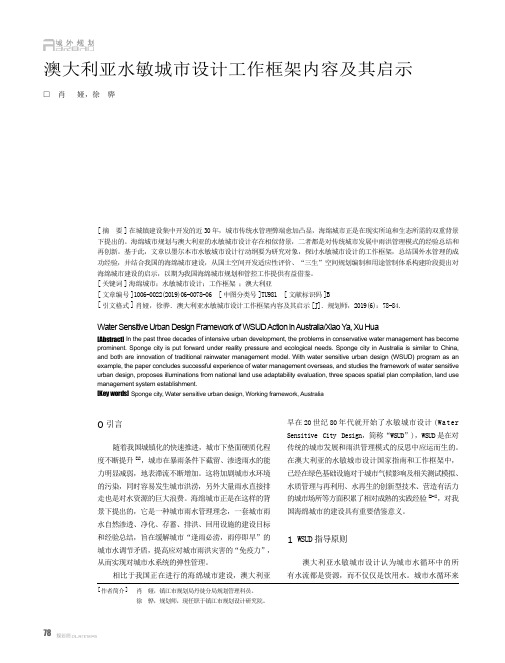
澳大利亚水敏城市设计工作框架内容及其启示□ 肖 娅,徐 骅[摘 要]在城镇建设集中开发的近30年,城市传统水管理弊端愈加凸显,海绵城市正是在现实所迫和生态所需的双重背景下提出的。
海绵城市规划与澳大利亚的水敏城市设计存在相似背景,二者都是对传统城市发展中雨洪管理模式的经验总结和再创新。
基于此,文章以墨尔本市水敏城市设计行动纲要为研究对象,探讨水敏城市设计的工作框架,总结国外水管理的成功经验,并结合我国的海绵城市建设,从国土空间开发适应性评价、“三生”空间规划编制和用途管制体系构建阶段提出对海绵城市建设的启示,以期为我国海绵城市规划和管控工作提供有益借鉴。
[关键词]海绵城市;水敏城市设计;工作框架 ;澳大利亚[文章编号]1006-0022(2019)06-0078-06 [中图分类号]TU981 [文献标识码]B[引文格式]肖娅,徐骅.澳大利亚水敏城市设计工作框架内容及其启示[J].规划师,2019(6):78-84.Water Sensitive Urban Design Framework of WSUD Action in Australia/Xiao Y a, Xu Hua[Abstract]In the past three decades of intensive urban development, the problems in conservative water management has becomeprominent. Sponge city is put forward under reality pressure and ecological needs. Sponge city in Australia is similar to China,and both are innovation of traditional rainwater management model. With water sensitive urban design (WSUD) program as anexample, the paper concludes successful experience of water management overseas, and studies the framework of water sensitiveurban design, proposes illuminations from national land use adaptability evaluation, three spaces spatial plan compilation, land usemanagement system establishment.[Key words] Sponge city, Water sensitive urban design, Working framework, Australia0引言随着我国城镇化的快速推进,城市下垫面硬质化程度不断提升[1],城市在暴雨条件下截留、渗透雨水的能力明显减弱,地表滞流不断增加。
二级建造师继续教育_海绵城市建设工程习题和答案解析

1、2014年11月,住房和城乡建设部出台了《海绵城市建设技术指南》,12月,住建部、财政部、水利部三部委联合启动了全国首批海绵城市建设试点城市申报工作。
2015年4月,从130多个申请城市中选出试点城市( )座.16。
02、最早提出LID理念与绿色基础建设,要求在源头维持和保护场地自然水文功能,强调还原开发前水文循环的国家是()。
美国3、由于水多,强调排水,并利用源头管理方法对径流和污染物进行控制,“排”的过程中体现可持续性的国家是()。
英国4、由于水少,采用水敏感城市设计,通过雨水源头控制,减少了暴雨径流,同时也增加供水的国家是()。
澳大利亚5、城市发展带来许多城市水问题,下面的选项中正确的是()。
A.水环境污染B。
水生态破坏D。
水资源短缺E。
水安全风险6、由降雨径流给城市水环境造成污染的主要原因有()。
A.初期径流污染C。
合流制溢流污染7、国家提出“以水定城”战略的主要原因是城市灰色基础设施建设容易给城市带来内涝等灾害,从而给国家造成巨额经济损失。
( )B.错误8、海绵城市建设应因城因地而异,科学规划、着眼于城市的可持续发展.这一工程具有复杂性和长期性,不会一蹴而就。
()A。
正确9、转变城市发展方式,推进海绵城市建设,可促进水资源的利用和环境保护,能够增强城市可持续发展能力。
()A。
正确10、在提升城市排水系统时要优先考虑把有限的雨水留下来,优先考虑更多利用自然力量排水,建设自然积存、自然渗透、自然净化的“海绵城市”。
( )A.正确11、国家提出“以水定城"战略的主要原因是城市灰色基础设施建设容易给城市带来内涝等灾害,从而给国家造成巨额经济损失.()B.错误12、海绵城市指城市能够像海绵一样,在适应环境变化和应对自然灾害等方面具有良好的“弹性”下雨时吸水、蓄水、渗水、净水,需要时将蓄存的水“释放"并加以利用。
据此,建设海绵城市的关键环节是( ).C.降低地表径流量13、国务院办公厅出台“关于推进海绵城市建设的指导意见”指出,采用渗、滞、蓄、净、用、排等措施,要求将多少降雨就地消纳和利用( )。
澳大利亚水敏性城市设计经验对我国海绵城市建设的启示
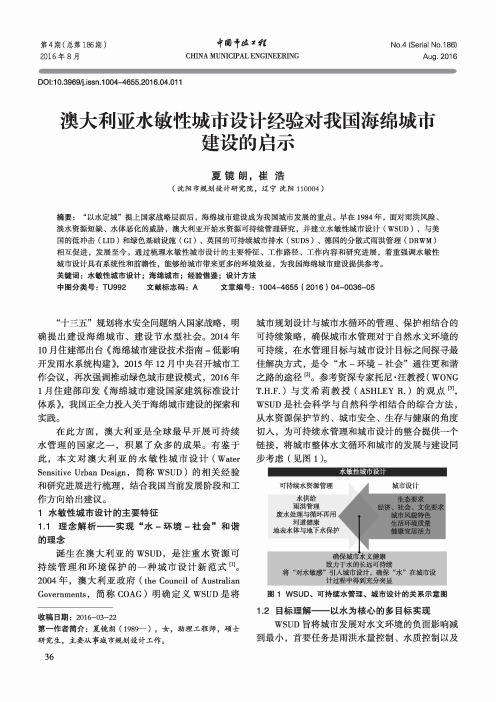
第4期(总第186期)中阖彳成*我No.4(Serial No.186) 2016 年 8 月CHINA MUNICIPAL ENGINEERING Aug.2016DOI:10.3969/j.issn.1004-4655.2016.04.011澳大利亚水敏性城市设计经验对我国海绵城市建设的启示夏镜朗,崔浩(沈阳市规划设计研究院,辽宁沈阳110004)摘要:“以水定城”提上国家战略层面后,海绵城市建设成为我国城市发展的重点。
早在1984年,面对雨洪风险、淡水资源短缺、水体恶化的威胁,澳大利亚开始水资源可持续管理研究,并建立水敏性城市设计(WSUD),与美 国的低冲击(LID)和绿色基础设施(GI)、英国的可持续城市排水(SUDS)、德国的分散式雨洪管理(DRWM)相互促进,发展至今。
通过梳理水敏性城市设计的主要特征、工作路径、工作内容和研究进展,着重强调水敏性 城市设计具有系统性和前瞻性,能够给城市带来更多的环境效益,为我国海绵城市建设提供参考。
关键词:水敏性城市设计;海绵城市;经验借鉴;设计方法中图分类号:TU992 文献标志码:A文章编号:1004-4655 (2016 ) 04-0036-05“十三五”规划将水安全问题纳人国家战略,明 确提出建设海绵城市、建设节水型社会。
2014年 10月住建部出台《海绵城市建设技术指南-低影响开发雨水系统构建》,2015年12月中央召开城市工 作会议,再次强调推动绿色城市建设模式,2016年 1月住建部印发《海绵城市建设国家建筑标准设计 体系》,我国正全力投人关于海绵城市建设的探索和 实践。
在此方面,澳大利亚是全球最早开展可持续水管理的国家之一,积累了众多的成果。
有鉴于 此,本文对澳大利亚的水敏性城市设计(Water Sensitive Urban Design,简称 WSUD)的相关经验和研究进展进行梳理,结合我国当前发展阶段和工 作方向给出建议。
1水敏性城市设计的主要特征1.1理念解析一一实现“水-环境-社会”和谐的理念诞生在澳大利亚的WSUD,是注重水资源可持续管理和环境保护的一种城市设计新范式[1]。
澳大利亚墨尔本水敏城市设计及启示
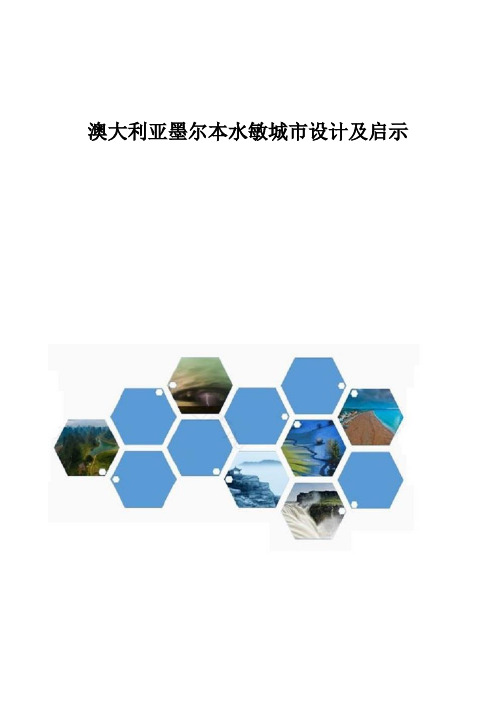
澳大利亚墨尔本水敏城市设计及启示传统城市扩张方式改变了城市原有地表类型,大量水泥、柏油等不透水硬化路面取代了原有的植被覆盖且渗水能力强的地面,从而破坏了城市水循环,使得城市生态系统退化,也影响了城市生态景观。
不透水性的硬化路面的大规模建设和应用,以及一些河道被衬砌水泥,使得城市的排水系统在大及特大降水面前不堪一击,以至于“在城市中看海”的景象常见。
降水会将不透水地面上的污染物、营养物质和化学物质冲刷进河道,最终流入水源地,造成水源地的面源污染,进而影响城市供水。
众所周知,气候变化使得极端天气频现,强降水事件、强热带气旋活动、干旱事件、海平面上升等对城市与水相关的基础设施带来更大挑战,也迫切要求城市采取更为积极的适应策略实现雨洪管理,促进城市水循环可持续性。
为此,研究发达国家在雨洪管理上的经验,对上海开展海绵城市试点,具有积极的借鉴意义。
一国际雨洪管理概念的发展人们对于雨洪管理的认识,从最初的单纯的土木工程建设,到关注受纳水体的生态,再到审美、景观、规划、社会等目标的融合。
图1展示了城市雨洪管理对象的发展历程。
当前,城市雨洪管理的内容包括防洪治理、休闲美观、水质保护、流态恢复、雨洪资源、生态系统健康、城市弹性和微气候构建等。
图1 国际城市雨洪管理目标与内容的演变(一)雨洪管理概念的比较图2 根据规范和聚焦领域的不同对雨洪管理概念的分类世界主要发达国家也对如何实现城市雨洪管理提出了各自的解决方案,如美国的低影响开发(Low-impact Development,LID)、英国的可持续城市排水系统(Sustainable Urban Drainage Systems,SUDS)以及本文要研究的澳大利亚的水敏城市建设(Water-sensitive Urban Design,WSUD)。
此外,如绿色基础设施(Green Infrastructure,GI)、综合性城市水管理(Integrated Urban Water Management,IUWM)、最佳管理实践(Best Management Practices,BMPs)等概念相继出现。
2017年二级建造师第三期继续教育试题 Microsoft Office Word 文档 (4)

50.?绿色屋顶设施养护规定,要定期检查()等排水设施。溢流口堵塞或淤积导致过水不畅时,应及时清理垃圾与沉积物。
A.溢流口B.排水沟C.水落口D.检查井E.排水管道
正确答案:A,B,C,D
51.?城市黑臭水体的整治技术选择应按照“控源截污、内源治理、活水循环、清水补给、水质净化、生态修复”的基本技术路线具体实施其中()是选择其他技术类型的基础与前提。
正确答案:B
23.?( )是工程项目全过程造价管理的核心和提高管理水平、经济效益的关键。
A.价值工程B.招标投标C.合同管理D.可行性研究
正确答案:C
24.?防洪调蓄的塑料雨水模块,其外围铺设透水性土工布,土工布外侧应有不少于()碎石。
A.25cmB.40cmC.30cmD.45cm
正确答案:C
25.?一个立管所承接的多个雨水斗,其安装高度宜在同一标高层。当立管的设计流量小于其排水能力时,可将不同高度的雨水斗接入该立管,但最低雨水斗应在立管底端与最高斗高差的()以上。
A.13.0B.14.0C.15.0D.16.0
正确答案:D
36.?小区内公共地面停车场、人行道、步行街、自行车道和休闲广场、室外庭院应采用透水铺装,新建、改建的公共建筑透水铺装率应不小于()。
A.70%B.50%C.35%D.60%
正确答案:A
37.?人工湿地技术是由人工建造和控制运行的湿地类型,其中表流人工湿地设计的水力停留时间约为()。
A.1-3年B.3-5年C.5-10年D.10年以上
正确答案:B
34.?屋面雨水用于绿地和道路浇洒,以下()工序可以不需要。
A.初期径流弃流B.消毒C.雨水蓄水池沉淀D.过滤
正确答案:B
澳大利亚水敏城市设计(WSUD)演进及对海绵城市建设的启示

67澳大利亚水敏城市设计(WSUD)演进及对海绵城市建设的启示Evolution of Water Sensitive Urban Design in Australia and Its Enlightenment to Sponge City摘 要:海绵城市建设需要多层面、全方位综合推进,针对目前中国海绵城市建设中面临的问题,通过解析澳大利亚城市水管理目标的转型及水敏城市设计(WSUD)演进过程,将水敏城市设计演进分为萌芽、产生、示范及应用4个阶段,进而分析其演进中的成功经验与前沿趋势,为我国当前海绵城市建设与低影响开发景观规划设计以启示与借鉴。
认为我国海绵城市建设需要从行政与制度建设、设计科学依据、项目监测与评价、项目示范推广,以及处置序列合理组织5个方面进行改进与突破,从而真正实现海绵城市的建设目标。
关 键 词:风景园林;澳大利亚;水敏城市设计(WSUD);演进;海绵城市Abstract: The construction of sponge city needs a multifaceted and comprehensive promotion. In view of the problems faced in the construction of sponge city, this paper analyzes the evolution process of the urban water management transformation and the Water Sensitive Urban Design (WSUD) in Australia, and then analyses the frontier and the successful experience, and provides inspiration and reference for China's current sponge city construction and landscape planning and design. It is believed that the construction of sponge city in China should be improved and breakthrough five aspects, namely, administrative and institutional construction, application technology innovation, project monitoring and evaluation, project demonstration and promotion, and rational organization of the disposal sequence, so as to truly realize the target of the construction of sponge city.Keywords: landscape architecture; Australia; Water Sensitive Urban Design (WSUD); evolution; sponge city景园林规划与设计[15-16]和风景园林教育[17]等方面都已得出大量研究成果。
water_sensitive_urban_design澳大利亚节水型城市设计
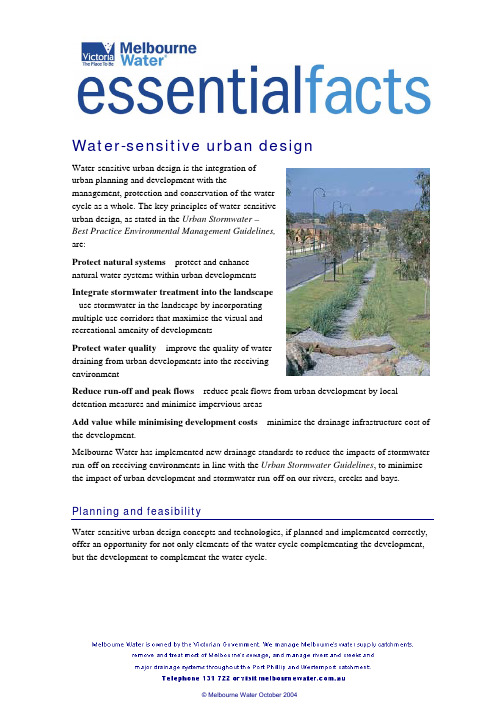
Water-sensitive urban designWater-sensitive urban design is the integration ofurban planning and development with themanagement, protection and conservation of the watercycle as a whole. The key principles of water-sensitiveurban design, as stated in the Urban Stormwater –Best Practice Environmental Management Guidelines,are:Protect natural systems – protect and enhancenatural water systems within urban developmentsIntegrate stormwater treatment into the landscape– use stormwater in the landscape by incorporatingmultiple use corridors that maximise the visual andrecreational amenity of developmentsProtect water quality – improve the quality of waterdraining from urban developments into the receivingenvironmentReduce run-off and peak flows – reduce peak flows from urban development by local detention measures and minimise impervious areasAdd value while minimising development costs – minimise the drainage infrastructure cost of the development.Melbourne Water has implemented new drainage standards to reduce the impacts of stormwater run-off on receiving environments in line with the Urban Stormwater Guidelines, to minimise the impact of urban development and stormwater run-off on our rivers, creeks and bays.Planning and feasibilityWater-sensitive urban design concepts and technologies, if planned and implemented correctly, offer an opportunity for not only elements of the water cycle complementing the development, but the development to complement the water cycle.To achieve the best possible results of implementation, the pre-planning phase must: •identify the land use capabilities and existing conditions or constraints of the site •consider the intended design and function of the proposed development•identify the likely impacts of the development on the existing environment•match these factors with the most appropriate water-sensitive urban design technologies designed to achieve a sustainable balance between development and environment.Water-sensitive urban design techniquesA range of applications are available for the integration of water-sensitive urban design concepts and technologies into urban developments. Types of techniques include (but are not limited to):•grassed or vegetated swales – primary treatment and conveyance function; can provide secondary treatment benefits•filtration trenches – primary treatment and conveyance and detention options; can provide secondary treatment benefits•bio-retention systems – secondary treatment, conveyance, detention and retention functions (through infiltration); can provide tertiary treatment benefits•wetlands – tertiary treatment system, storage, detention, possible reuse options•rainwater tanks – using stormwater as a resource – detention, retention, a substitute for drinking water in garden irrigation, car washing, toilet flushing, etc•greywater reuse – collect from households, primary treatment on site, reuse for external irrigation or internal toilet flushing options•rain gardens, rooftop greening, urban forests – provide natural vegetated features of aesthetic value and provide treatment function by filtering stormwater•any combination of these and other techniques for the best possible outcome.Lynbrook Estate – a demonstrationLynbrook Estate is an 800-lot residentialdevelopment approximately 35km south-east of Melbourne. It is the firstresidential development in Melbourne ofthis scale to integrate water-sensitiveurban design principles and features forstormwater management.The Lynbrook Estate project is the resultof collaboration between MelbourneWater (drainage authority), the Urban andRegional Land Corporation (developer) and their consultant team of KLM Development Consultants and Murphy Design Group Landscape Architects, together with the Cooperative Research Centre for Catchment Hydrology (performance monitoring) and the City of Casey (local council).Features of the estate include the capture of roof and road run-off into vegetated buffer strips above gravel-filled conveyance trenches (ie grassed swales) at the local streetscape level. The local street swales connect to the central boulevard of the estate, where a landscaped median strip has been modified to provide further treatment and conveyance of stormwater. This component is called a bio-retention system and is incorporated into a standard road width of 16 metres with a one-way crossfall – no kerbs, gutters or side entry pits.Tertiary treatment is provided by constructed wetlands downstream of the bio-retention system, which provides the final treatment of stormwater before being discharged into the ornamental lake and then the local waterway. Treated stormwater is harvested from the lake via a gravity-fed exfiltration trench to irrigate the 7.5 hectare Town Park and remnant River Red Gums.The water-sensitive urban design features minimise the impact of the new development on the environment, significantly reducing pollutant loads of suspended solids, nitrogen, phosphorus and heavy metals from entering local rivers and creeks and Port Phillip Bay. The combined stormwater treatment system at Lynbrook has reduced pollutant loads in estate run-off by 80% for total phosphorus, 60% for total nitrogen and 90% for total suspended solids. These results exceed the target reductions as specified in the Urban Stormwater Guidelines of 45% total nitrogen, 45% total phosphorus and 80% for total suspended solids.In 2000, the innovative design of the Lynbrook Estate was awarded the prestigious President’s Award for Excellence by the Urban Development Institute of Australia.。
2017年二级建造师继续教育题库
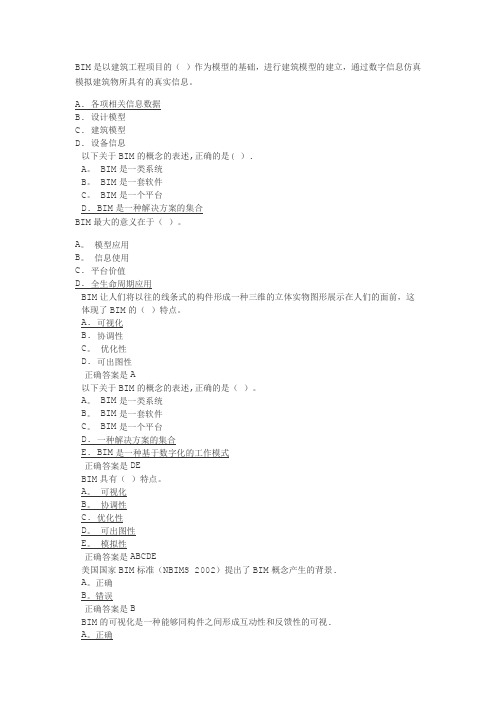
BIM是以建筑工程项目的()作为模型的基础,进行建筑模型的建立,通过数字信息仿真模拟建筑物所具有的真实信息。
A. 各项相关信息数据B. 设计模型C. 建筑模型D. 设备信息以下关于BIM的概念的表述,正确的是( ).A。
BIM是一类系统B。
BIM是一套软件C。
BIM是一个平台D. BIM是一种解决方案的集合BIM最大的意义在于()。
A。
模型应用B。
信息使用C. 平台价值D. 全生命周期应用BIM让人们将以往的线条式的构件形成一种三维的立体实物图形展示在人们的面前,这体现了BIM的()特点。
A. 可视化B. 协调性C。
优化性D. 可出图性正确答案是A以下关于BIM的概念的表述,正确的是()。
A。
BIM是一类系统B。
BIM是一套软件C。
BIM是一个平台D. 一种解决方案的集合E. BIM是一种基于数字化的工作模式正确答案是DEBIM具有()特点。
A。
可视化B。
协调性C. 优化性D。
可出图性E。
模拟性正确答案是ABCDE美国国家BIM标准(NBIMS 2002)提出了BIM概念产生的背景.A。
正确B。
错误正确答案是BBIM的可视化是一种能够同构件之间形成互动性和反馈性的可视.A。
正确B.错误正确答案是ABIM建筑信息模型可在建筑物建造前期对各专业的碰撞问题进行协调,生成协调数据。
A.正确B。
错误正确答案是ABIM包含项目建设周期中所有的真实相关信息。
A.正确B。
错误正确答案是A•最早关于 BIM 的概念是( )年提出的。
A.1948.0•B。
1975.0•C。
1998.0D。
2002。
0••()的颁布,标志着 BIM 技术真正成为我国建筑信息化的主线,也成为我国的“BIM 元年”.A. 《建设领域信息化工作基本要点》• B. 《建筑对象数字化定义》• C. 《2011—2015 年建筑业信息化发展纲要》D. 《PBIMS标准》••正确答案是C•BIM技术最先从()发展开来.A. 英国• B. 美国• C. 日本D。
- 1、下载文档前请自行甄别文档内容的完整性,平台不提供额外的编辑、内容补充、找答案等附加服务。
- 2、"仅部分预览"的文档,不可在线预览部分如存在完整性等问题,可反馈申请退款(可完整预览的文档不适用该条件!)。
- 3、如文档侵犯您的权益,请联系客服反馈,我们会尽快为您处理(人工客服工作时间:9:00-18:30)。
Water-sensitive urban designWater-sensitive urban design is the integration ofurban planning and development with themanagement, protection and conservation of the watercycle as a whole. The key principles of water-sensitiveurban design, as stated in the Urban Stormwater –Best Practice Environmental Management Guidelines,are:Protect natural systems – protect and enhancenatural water systems within urban developmentsIntegrate stormwater treatment into the landscape– use stormwater in the landscape by incorporatingmultiple use corridors that maximise the visual andrecreational amenity of developmentsProtect water quality – improve the quality of waterdraining from urban developments into the receivingenvironmentReduce run-off and peak flows – reduce peak flows from urban development by local detention measures and minimise impervious areasAdd value while minimising development costs – minimise the drainage infrastructure cost of the development.Melbourne Water has implemented new drainage standards to reduce the impacts of stormwater run-off on receiving environments in line with the Urban Stormwater Guidelines, to minimise the impact of urban development and stormwater run-off on our rivers, creeks and bays.Planning and feasibilityWater-sensitive urban design concepts and technologies, if planned and implemented correctly, offer an opportunity for not only elements of the water cycle complementing the development, but the development to complement the water cycle.To achieve the best possible results of implementation, the pre-planning phase must: •identify the land use capabilities and existing conditions or constraints of the site •consider the intended design and function of the proposed development•identify the likely impacts of the development on the existing environment•match these factors with the most appropriate water-sensitive urban design technologies designed to achieve a sustainable balance between development and environment.Water-sensitive urban design techniquesA range of applications are available for the integration of water-sensitive urban design concepts and technologies into urban developments. Types of techniques include (but are not limited to):•grassed or vegetated swales – primary treatment and conveyance function; can provide secondary treatment benefits•filtration trenches – primary treatment and conveyance and detention options; can provide secondary treatment benefits•bio-retention systems – secondary treatment, conveyance, detention and retention functions (through infiltration); can provide tertiary treatment benefits•wetlands – tertiary treatment system, storage, detention, possible reuse options•rainwater tanks – using stormwater as a resource – detention, retention, a substitute for drinking water in garden irrigation, car washing, toilet flushing, etc•greywater reuse – collect from households, primary treatment on site, reuse for external irrigation or internal toilet flushing options•rain gardens, rooftop greening, urban forests – provide natural vegetated features of aesthetic value and provide treatment function by filtering stormwater•any combination of these and other techniques for the best possible outcome.Lynbrook Estate – a demonstrationLynbrook Estate is an 800-lot residentialdevelopment approximately 35km south-east of Melbourne. It is the firstresidential development in Melbourne ofthis scale to integrate water-sensitiveurban design principles and features forstormwater management.The Lynbrook Estate project is the resultof collaboration between MelbourneWater (drainage authority), the Urban andRegional Land Corporation (developer) and their consultant team of KLM Development Consultants and Murphy Design Group Landscape Architects, together with the Cooperative Research Centre for Catchment Hydrology (performance monitoring) and the City of Casey (local council).Features of the estate include the capture of roof and road run-off into vegetated buffer strips above gravel-filled conveyance trenches (ie grassed swales) at the local streetscape level. The local street swales connect to the central boulevard of the estate, where a landscaped median strip has been modified to provide further treatment and conveyance of stormwater. This component is called a bio-retention system and is incorporated into a standard road width of 16 metres with a one-way crossfall – no kerbs, gutters or side entry pits.Tertiary treatment is provided by constructed wetlands downstream of the bio-retention system, which provides the final treatment of stormwater before being discharged into the ornamental lake and then the local waterway. Treated stormwater is harvested from the lake via a gravity-fed exfiltration trench to irrigate the 7.5 hectare Town Park and remnant River Red Gums.The water-sensitive urban design features minimise the impact of the new development on the environment, significantly reducing pollutant loads of suspended solids, nitrogen, phosphorus and heavy metals from entering local rivers and creeks and Port Phillip Bay. The combined stormwater treatment system at Lynbrook has reduced pollutant loads in estate run-off by 80% for total phosphorus, 60% for total nitrogen and 90% for total suspended solids. These results exceed the target reductions as specified in the Urban Stormwater Guidelines of 45% total nitrogen, 45% total phosphorus and 80% for total suspended solids.In 2000, the innovative design of the Lynbrook Estate was awarded the prestigious President’s Award for Excellence by the Urban Development Institute of Australia.。
